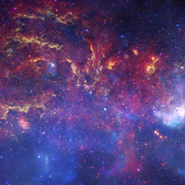What in the Universe: Omega Centauri Star Cluster
Video Player
Video Versions
Why are these stars different colors?
Produced by the Space Telescope Science Institute’s Office of Public Outreach in collaboration with NASA’s Universe of Learning partners: Caltech/IPAC, Center for Astrophysics | Harvard & Smithsonian, NASA Jet Propulsion Laboratory, and Sonoma State University.
- Hubble Space Telescope image of the Omega Centauri star cluster: NASA, ESA and the Hubble SM4 ERO Team
- Illustrations and animations: Leah Hustak (STScI)
- Hubble Space Telescope image of star cluster NGC 290: ESA and NASA
Written by Margaret W. Carruthers
Designed by Leah Hustak and Dani Player
Editorial and design input from Dr. Quyen Hart and Yesenia Perez
Music from Music for Non-profits
Designed by Leah Hustak and Dani Player
Editorial and design input from Dr. Quyen Hart and Yesenia Perez
Music from Music for Non-profits
(SPEECH)
[AWE-INSPIRING MUSIC]
(DESCRIPTION)
Red square against starry sky. Icons, star, galaxy, constellation, asteroid, solar system. Text, what in the universe.
Red square against starry sky. Icons, star, galaxy, constellation, asteroid, solar system. Text, what in the universe.
Why are the stars different colors? A, They have different temperatures. B, They are made of different elements. C, They are moving in different directions. D, They are different distances from the Earth.
Colorful starry sky, red, blue, yellow, green.
A is highlighted, they have different temperatures.
Globular Star Cluster, Omega Centauri, Halo of the Milky Way. A cluster of roughly 10 million stars orbiting the center of the Milky Way, approximately 16,000 light-years from Earth. Hubble Space Telescope, ultraviolet, visible, and infrared light.
The cluster includes yellow-white Sun-like stars, large red giant stars, bluish giant stars, and small white dwarfs.
The overall color of a star, the color that human eyes can perceive, depends entirely on its surface temperature.
Hotter stars appear bluer because they give off more blue light than red light.
Cooler stars appear redder because they give off more red light than blue light.
Medium temperature stars like the Sun appear yellow.
The temperature and therefore the color of a star is related to its size and mass. Same size, different mass, red, low mass, yellow, medium, blue, high.
For example, if two stars are the same size, the more massive star is denser and therefore hotter and bluer.
Or, if two stars have the same mass, the smaller star is denser, hotter, and bluer.
Stars can change color over time as they change in size and density, and therefore surface temperature.
For example, a hot blue star can turn yellow and then red as it ages, expands, decreases in density, and its surface cools.
While it is difficult to estimate the size, mass, or age of a star just by looking at it, we can gauge its temperature, even without a telescope.
Just look at its color.


